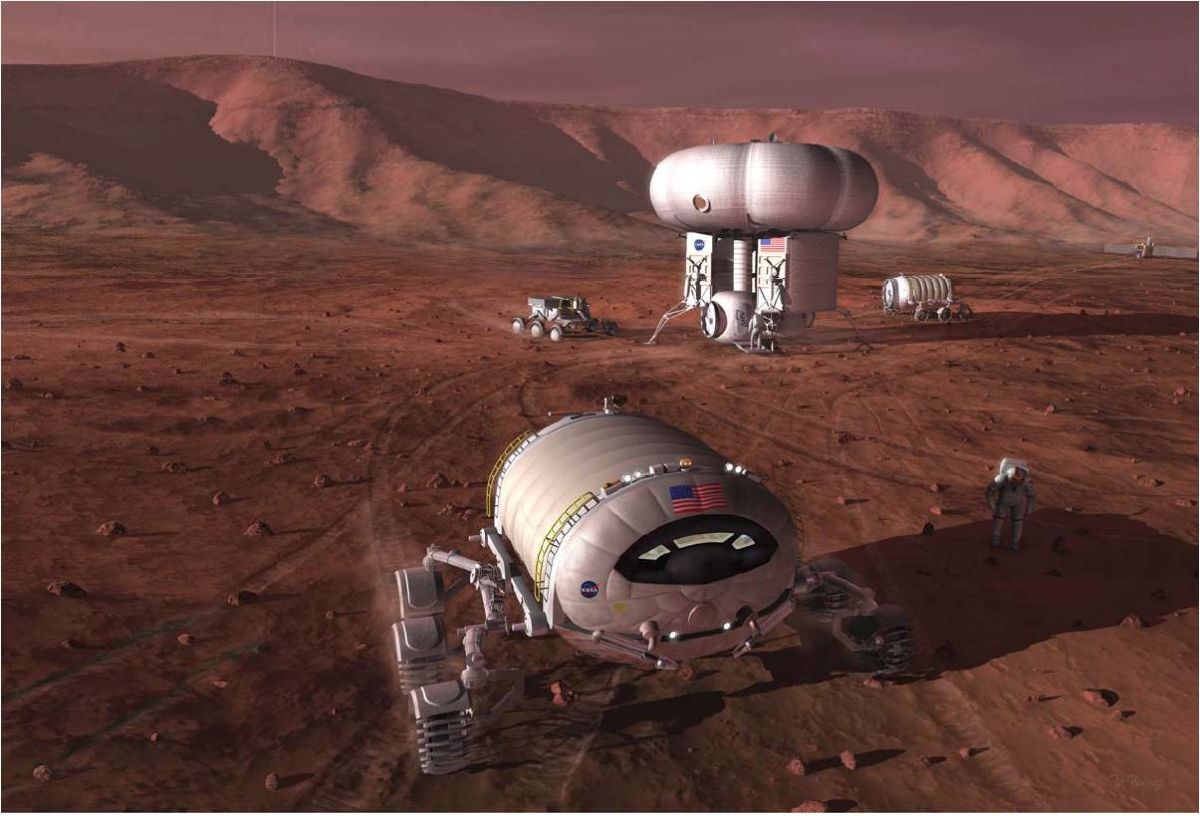Mars Society Founder Makes Case for 'Mars Direct' Path to the Red Planet
The 30-year-old plan has stood the test of time, Robert Zubrin stressed.

WASHINGTON — Both SpaceX and NASA have ideas about how to get humans to the Red Planet, but the founder of the Mars Society says there's a better way to do it.
In a colorful talk here at the International Astronautical Congress (IAC) on Oct. 23, Robert Zubrin made the case for his long-standing "Mars Direct" plan. Mars Direct, Zubrin argued, makes more sense than SpaceX's current Starship architecture and the plans of NASA, which may use the Gateway lunar space station as a staging point for human Mars missions.
Mars Direct, which Zubrin first proposed in the late 1980s and early 1990s, calls for an Earth Return Vehicle (ERV) that launches uncrewed to Mars and arrives at the Red Planet six months later. Aboard this spacecraft will be a nuclear-powered rover that generates rocket fuel from the carbon-dioxide-dominated Martian atmosphere. This rover's work will ensure that the ERV's fuel tank is topped up on the Red Planet.
Related: How Living on Mars Could Challenge Colonists (Infographic)
More: Space News from the 70th International Astronautical Congress
Two more spacecraft would launch from Earth to Mars at the next available window, 26 months after the ERV took flight: a second ERV, and a habitat carrying the astronauts.
The crew then would spend 18 months on Mars before returning to Earth. Half a year later, they would arrive back on their home planet, and the next ERV and habitat combination would already be flying to the Red Planet, Zubrin suggested.
But this plan is not what SpaceX or NASA want to do, Zubrin said in his talk.
Starship too big?
SpaceX's Starship has gone through multiple design and name changes since company founder and CEO Elon Musk unveiled the basic architecture in September 2016 under the moniker "Interplanetary Transport System."
Breaking space news, the latest updates on rocket launches, skywatching events and more!
The latest iteration features a reusable spaceship and rocket called Starship and Super Heavy, respectively, that will stand 387 feet (118 meters) tall when stacked. Starship will be powered by six of SpaceX's next-generation Raptor engines, and Super Heavy will have slots for 37 Raptors (though some of these slots may be empty on operational missions).
Super Heavy will launch Starship to orbit, then come back down for landing and reuse. Starship, meanwhile, will fuel up in Earth orbit and zoom off to Mars. It will land on the Red Planet, be refueled there using local resources (as in the Mars Direct vision) and eventually launch off the Martian surface to come back toward Earth.
Related: SpaceX's Starship and Super Heavy Mars Rocket in Pictures
"In short, this is the wrong way to use a Starship," Zubrin told a standing-room-only crowd at the conference, arguing that the propellant requirements would be excessive for such a large vehicle. Instead, he said, "Starship could be used as a fully reusable Earth to LEO [low Earth orbit] heavy-lift vehicle." And from there, payloads could stage off Starship to head to Mars.
Zubrin proposed using another spacecraft — a sort of mini-Starship — to "stage off of Starship." It would be sized to be a fully reusable upper stage of SpaceX's workhorse Falcon 9 rocket. Zubrin said this would reduce the fuel requirements sixfold. "So, rather than being a 120-ton-to-orbit kind of vehicle, it's a 20-ton-to-orbit vehicle," he explained.
Zubrin said that NASA could then work to build a Mars lander to help Musk's Starship plans, since "Starship is all he's doing." Zubrin further suggested that NASA could develop a 10-ton or more "Mars-class lander" that could be sent off of Starship or the Space Launch System, the giant rocket that NASA is developing to send crews to the moon and Mars.
While NASA's plans for a Mars mission around 2035 are still under development, the agency has proposed using a deep-space transport spacecraft, a reusable vehicle that can use both chemical and electric propulsion. This craft would cycle between the Gateway and Mars, bringing cargo and astronauts back and forth as required.
Using the Gateway would allow the transport spacecraft to be "serviced and sent out again" to the Red Planet, NASA argued in a 2017 description. Gateway would also be a natural gathering spot to foster international and private partnerships, which NASA is trying to achieve for cost and multilateral support as the agency works to land humans on the moon by 2024.
Zubrin argued that the agency should reconsider this approach. "The reason they are building the lunar orbit Gateway is because we don't have a heavy Mars lander," Zubrin said in the IAC talk. "You don't solve that by building a lunar orbit Gateway. You solve that by building a heavy Mars lander."
He also said that using Gateway would add more time to a Mars mission, because astronauts would have to go the moon-orbiting outpost first.
In a news conference at IAC the following day (Oct. 24), NASA Administrator Jim Bridenstine said the agency is considering several architectures for human Mars missions (without getting into specifics about which ones are under consideration). He said a 2033 or 2035 mission could be possible "if the budgets were to materialize," and one possible scenario might include a Venus gravity assist to go faster. The agency is also looking at scenarios where astronauts would spend 30 days on the Martian surface before going home, or making a two-year Red Planet stay, depending on what resources are available.
Zubrin brought up a few alternative architectures for the plan that he's heard from the community, including the idea of sending Starship to the moon before going to Mars.
"Sending a Starship to the moon is like sending a carrier aircraft whitewater rafting. It's the wrong spot for it," Zubrin said to audience laughter. One issue would be the amount of ejecta Starship would produce in the lunar environment, which could not only damage any lunar settlement nearby, but the Starship itself, he said.
- Elon Musk Takes Us Inside SpaceX's Starship Mk1 Prototype (Video)
- Astronauts Will Face Many Hazards on a Journey to Mars
- How We Could Make Mars Habitable, One Patch of Ground at a Time
Follow Elizabeth Howell on Twitter @howellspace. Follow us on Twitter @Spacedotcom and on Facebook.


Elizabeth Howell (she/her), Ph.D., was a staff writer in the spaceflight channel between 2022 and 2024 specializing in Canadian space news. She was contributing writer for Space.com for 10 years from 2012 to 2024. Elizabeth's reporting includes multiple exclusives with the White House, leading world coverage about a lost-and-found space tomato on the International Space Station, witnessing five human spaceflight launches on two continents, flying parabolic, working inside a spacesuit, and participating in a simulated Mars mission. Her latest book, "Why Am I Taller?" (ECW Press, 2022) is co-written with astronaut Dave Williams.
